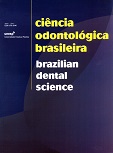Shear bond strength between composite resins to cast titanium and gold alloy
DOI:
https://doi.org/10.14295/bds.2003.v6i1.184Resumo
New indirect composites with improved qualities have been introduced as alternative to porcelain. There is little information regarding the bond strength of the new metal resin bonding systems, mainly when they are applied onto titanium surfaces. This study evaluated the shear bond strength of two indirect composite resin (Artglass/Heraeus Kulzer and Targis/Ivoclar) to cast titanium (Ti) and gold alloy (Au). Twenty metallic structures (4mm in diameter, 4,0mm thick) of each alloy were cast shaped and abraded with 250mm aluminum oxide before the application of the bond system for each polymer. Artglass opaque, dentin and enamel composite were applied using teflon matrices onto titanium and gold alloy structures. The same procedure was achieved to Targis and they were polymerized according to the manufactures' recommendations. The samples were stored in distilled water for 24 hours at 37ºC and thermocycled (5º and 55ºC/3000 cycles). Shear bond strength tests were performed by using an Instron Universal testing machine at a crosshead speed of 5mm/min. Data were analyzed statistically with 2-way ANOVA and Tukey test (a=0,5). The results indicated that the gold alloy was statistically better than the cast titanium (18,44MPa and 9,81MPa respectively) and Targis ceromer (16,61 MPa) showed significant higher shear bond strength than Artglass polyglass (11,64MPa) in all tested alloys. The best result was achieved when the ceromer was applied onto gold alloy.Downloads
Downloads
Publicado
Como Citar
Edição
Seção
Licença
TRANSFERÊNCIA DE DIREITOS AUTORAIS E DECLARAÇÃO DE RESPONSABILIDADE
Toda a propriedade de direitos autorais do artigo "____________________________________________________________________" é transferido do autor(es) para a CIÊNCIA ODONTOLÓGICA BRASILEIRA, no caso do trabalho ser publicado. O artigo não foi publicado em outro lugar e não foi submetido simultaneamente para publicação em outra revista.
Vimos por meio deste, atestar que trabalho é original e não apresenta dados manipulados, fraude ou plágio. Fizemos contribuição científica significativa para o estudo e estamos cientes dos dados apresentados e de acordo com a versão final do artigo. Assumimos total responsabilidade pelos aspectos éticos do estudo.
Este texto deve ser impresso e assinado por todos os autores. A versão digitalizada deverá ser apresentada como arquivo suplementar durante o processo de submissão.




























